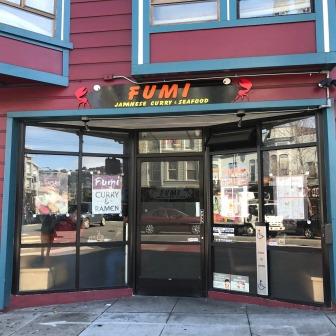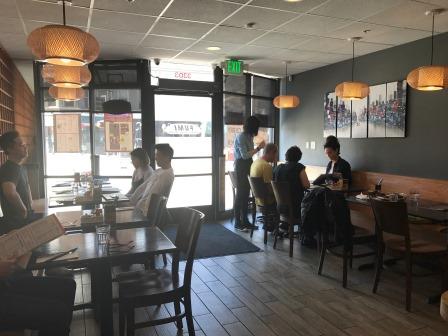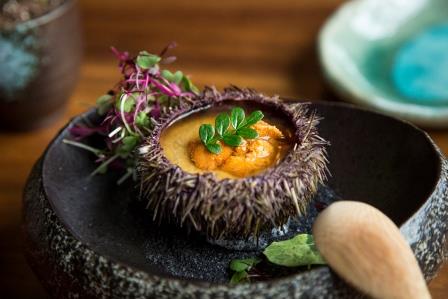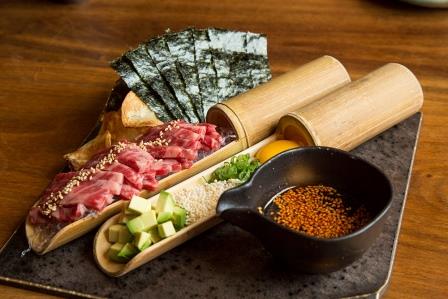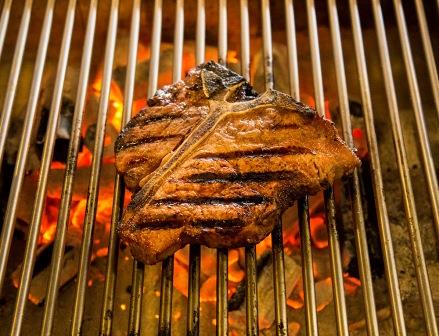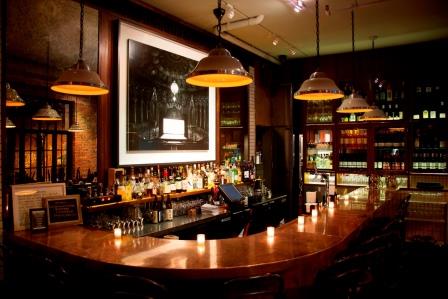True Japanese style curry found in a hide-out like place
By Elli Sekine
If you walk through the fashionable Mission District where young people gather, and further through the south big street, you arrive at a low-key district where residential and commercial buildings are mixed together. On one such small street, I found a Japanese restaurant which did not really stand out. The sign says “Japanese curry, ramen, and sushi”, and the menu covers everything you can think of. I almost passed by without stopping because the exterior did not look very appealing; however, I felt something genuine about the “Japanese curry” part, and decided to check it out. There is no consistency in the menu which is filled with various sushi and ramen dishes, but the curry section has 15 different kinds from the regular type to black curry, teppan (iron grill) curry, etc. I did not see any Japanese staff in the front area or in the kitchen, but the curry delivered to my table surprised me with its authentic homemade taste. I felt like I had just found a treasure on an island. In such a quiet looking restaurant in such an isolated area far from the city center, you can still find passion for curry making.
The chef who is in charge of the curry menu is the co-owner/manager, Max Wang, but the recipe is provided by Fumi, a Japanese woman, just as I thought.
Although Fumi-san was the recipe provider and the partner, she does not work at the restaurant. Mr. Wang does everything from running the kitchen to managing the front. I wondered why a Chinese man was able to make true Japanese curry.
Mr. Wang worked at a Japanese restaurant while he was still going to school, and slowly learned the skill of making sushi. He met Fumi-san when he was working at a Hawaiian Japanese restaurant, “Chin’s Sushi Bar” in the financial district.
He tasted Fumi’s curry for the first time then, and became a big fan of delicious Japanese curry. He wanted to learn how to make Japanese curry badly, so he always helped her prepare her curry. During those times, an opportunity to open a restaurant came to him. However, the theme of the restaurant was not curry, but “Sushi” which is easy to appeal to Americans. He took it, and worked as the owner/sushi chef of “Crazy Sushi” for 10 years. After he sold the restaurant, he set his goal for opening that unforgettable Japanese curry restaurant with Fumi. He tried Japanese curry dishes of the Bay area for his research. “Most of them are served either at delis or take-out places. I wanted to open a place where people can enjoy home-style delicious curry in a more relaxed setting,” said Mr. Wang. However, Japanese curry was not well known amongst Americans, and the business did not go well. Until Americans learn to know the true appeal of Japanese curry, he thought it would be better to include sushi and ramen on the menu. They even offered a delivery service. That gave American customers a chance to try curry, and they liked it. One such customer is San Francisco journalist, Chris Kohler. He recommended “Fumi Curry” as his favorite curry restaurant in the Japanese “GQ” magazine.
Their signature curry menu section makes Japanese curry fans excited with its rich contents. Popular items are pork cutlet curry, chicken cutlet curry, and beef curry. Other items include black curry using squid ink, and teppan curry which has eggs on the bottom on an iron plate, then rice, then cutlet and fried shrimp, etc. on top, and curry is poured on top so you eat while everything is still hot. The original recipe of the curry uses spices such as turmeric, cumin, cardamom, chili, and ginger to cook potatoes, carrots, and other vegetables for a long time until all the vegetables no longer hold their shape. In addition, there are other items created by Mr. Wang, with which make this restaurant different, and more unique than other curry restaurants, such as nugget-shaped grated gobo vegan topping, fried crab teppan curry, etc. The curry is well-balanced with the perfect combination of sweetness and sourness, and tastes like home-cooking with richness and umami, yet with a professional quality you cannot easily replicate at home.
Existence of B-class gourmet restaurants are important for San Francisco where the commodity prices are the highest in the nation. The Mission district is only 2 blocks away, and prices are still rising. This restaurant is a hidden gem where you can eat Japanese comfort foods at reasonable prices. The Bernal Heights where “Fumi Curry” is located used to be an area where residents and businesses were mixed together, and a town far from trendy stuff, but it is now changing with an influence of the increase of residents in the IT industry. The old buildings are being modernized, and some tenants are turning them into cafés.
Even in San Francisco, the gourmet city, the typical Japanese foods still mean sushi and ramen, and the main-stream curry is Thai or Indian. The Japanese curry made mainly with vegetables with relatively less oil and spices is lighter and easier to eat, and well-accepted by first-time American curry eaters. Needless to say, curry ranks at the top in home-cooking in Japan. I expect that the number of curry fans will surely rise in the US from now on.
隠れ家的な本格派ジャパニーズカレー
若者で賑わうファッショナブルなミッション地区から南大通りを超えると、商業が混在する垢抜けないエリアになる。その小さな通りで一軒の目立たない日本食レストランを発見した。看板には「ジャパニーズカレー、ラーメン、寿司」となんでもアリのメニューが描いてある。店構えもパッとせず、通り過ぎようとしたが、英語で書かれたジェパニーズカレーの説明が目を惹き、店内に入ってみた。他にも寿司、ラーメンがメニューを賑わせ一貫性はないが、カレーはレギュラーに加え黒カレーや鉄板カレーなど15種類はある。日本人は一人も見当たらなかったが、運ばれてきたカレーは、本格的な手作りの味だったので驚いた。まるで島で宝を見つけたような気持ちだ。こんな街外れの地味な外観の店も突き詰めれば、カレー作りのパッションが見えてきた。
カレーを担当するシェフは、共同経営者兼マネージャーのMax Wang氏。レシピはやはり日本人女性のフミさんによるものだった。しかしフミさんは、レシピ提供者で経営パートナーでありながら店には出ていない。Wang氏がキッチンからフロントまで切り盛りしている。なぜ中国人の同氏が日本カレーを作れるのだろうと疑問に思った。彼は学生時代から日本食レストランで働きながら、少しずつ寿司を握る技術を身につけていった。彼が金融街にあったハワイアンジャパニーズレストラン「Chinʼs Sushi bar」で働いている時にFumiさんに出会った。
その時、彼女が作るカレーをはじめて食し、その美味しさにジャパニーズカレーの大ファンになったという。フミさんのカレーの作り方を覚えたくていつも仕込みを手伝っていた。そのうちレストランをオープンする機会が舞い込んできたが、テーマはカレーではなくアメリカ人にわかりやすい「寿司」。「Crazy Sushi」のオーナー、寿司シェフとして10年経営を続けた。その店舗売却後、あの忘れなれないジャパニーズカレーの出店をフミさんと目指すことになる。ベイエリアのジャパニーズカレーを食べ歩き研究をした。「ほとんどはデリかテイクアウトなので、家庭的な美味しいカレーをゆっくり食べれる店を出したかった」とWang氏。しかし、ジャパニーズカレーはまだアメリカ人には知名度が低く、経営困難をきたした。
「アメリカ人がカレーの魅力を知るまでは」と寿司やラーメンをメニューに追加し、デリバリーも始めた。ラーメンの客がカレーも試す機会もあり、食べたアメリカ人からは好評で少しずつリピーターも増えた。その一人であるサンフランシスコのジャーナリスト、Chiris Kohler氏は、日本の「GQ」マガジンで、一番のお気に入りのカレー店としてFumi Curry」を紹介している。
看板である、種類豊富なメニューは、ジャパニーズカレーファンをワクワクさせる内容。人気のカツカレー、チキンカツカレー、ビーフカレーを始め、イカスミを加えた黒ラーメン、鉄板に卵を敷き、ライスの上にカツや海老などを載せ、上からカレーをかけ、アツアツのうちに食べる。レシピは、ターメリック、クミン、カードミン,チリ、ジンジャーなどのスパイス、ジャガイモ、ニンジン、他の野菜をたっぷり時間をかけ原型を残さず煮込むオリジナルレシピ。さらにWang氏が開発したゴボウを擦ってチキンナゲットのよう形状したベーガントッピングや蟹フライ鉄板カレーなどのアディアは他店と差をつけている。味は甘みと酸味が絶妙なバランスでコクと旨味が加わった家庭の味なのだが、一般家庭ではなかなか出せない本格派カレーだ。
全米一の物価高といわれるSFでB級グルメは貴重な存在。しかも2ブロック先のミッション地区では値段が高騰しているだけに、ここは日本のコンフォートフードがリーズナブルな料金で食べられる穴場的存在だ。「Fumi Curry」があるバーナルハイツは、トレンドとは程遠い雑居地区だったが、最近IT 関係の住居者が増えている影響で、古い建物がモダンに改装されたり、ビルのテナントがカフェになったり街の様相が変わりつつある。
グルメの街、サンフランシスコでも、未だに日本食といえば寿司、ラーメンが中心でカレーといえばタイかインドが主流だが、野菜中心で油と香辛料が少ないジャパニーズカレーは、ライトで健康的だというアピールでアメリカ人のファンが増えれば、次のブームになる可能性もある。日本では言わずと知れた一番人気の家庭料理。米国におけるジャパニーズカレーの発展を期待するばかりだ。
FUMI Japanese curry
3303 Mission St, San Francisco, CA 94110
(415) 757-0901
http://www.fumisf.com/
If you walk through the fashionable Mission District where young people gather, and further through the south big street, you arrive at a low-key district where residential and commercial buildings are mixed together. On one such small street, I found a Japanese restaurant which did not really stand out. The sign says “Japanese curry, ramen, and sushi”, and the menu covers everything you can think of. I almost passed by without stopping because the exterior did not look very appealing; however, I felt something genuine about the “Japanese curry” part, and decided to check it out. There is no consistency in the menu which is filled with various sushi and ramen dishes, but the curry section has 15 different kinds from the regular type to black curry, teppan (iron grill) curry, etc. I did not see any Japanese staff in the front area or in the kitchen, but the curry delivered to my table surprised me with its authentic homemade taste. I felt like I had just found a treasure on an island. In such a quiet looking restaurant in such an isolated area far from the city center, you can still find passion for curry making.
The chef who is in charge of the curry menu is the co-owner/manager, Max Wang, but the recipe is provided by Fumi, a Japanese woman, just as I thought.
Although Fumi-san was the recipe provider and the partner, she does not work at the restaurant. Mr. Wang does everything from running the kitchen to managing the front. I wondered why a Chinese man was able to make true Japanese curry.
Mr. Wang worked at a Japanese restaurant while he was still going to school, and slowly learned the skill of making sushi. He met Fumi-san when he was working at a Hawaiian Japanese restaurant, “Chin’s Sushi Bar” in the financial district.
He tasted Fumi’s curry for the first time then, and became a big fan of delicious Japanese curry. He wanted to learn how to make Japanese curry badly, so he always helped her prepare her curry. During those times, an opportunity to open a restaurant came to him. However, the theme of the restaurant was not curry, but “Sushi” which is easy to appeal to Americans. He took it, and worked as the owner/sushi chef of “Crazy Sushi” for 10 years. After he sold the restaurant, he set his goal for opening that unforgettable Japanese curry restaurant with Fumi. He tried Japanese curry dishes of the Bay area for his research. “Most of them are served either at delis or take-out places. I wanted to open a place where people can enjoy home-style delicious curry in a more relaxed setting,” said Mr. Wang. However, Japanese curry was not well known amongst Americans, and the business did not go well. Until Americans learn to know the true appeal of Japanese curry, he thought it would be better to include sushi and ramen on the menu. They even offered a delivery service. That gave American customers a chance to try curry, and they liked it. One such customer is San Francisco journalist, Chris Kohler. He recommended “Fumi Curry” as his favorite curry restaurant in the Japanese “GQ” magazine.
Their signature curry menu section makes Japanese curry fans excited with its rich contents. Popular items are pork cutlet curry, chicken cutlet curry, and beef curry. Other items include black curry using squid ink, and teppan curry which has eggs on the bottom on an iron plate, then rice, then cutlet and fried shrimp, etc. on top, and curry is poured on top so you eat while everything is still hot. The original recipe of the curry uses spices such as turmeric, cumin, cardamom, chili, and ginger to cook potatoes, carrots, and other vegetables for a long time until all the vegetables no longer hold their shape. In addition, there are other items created by Mr. Wang, with which make this restaurant different, and more unique than other curry restaurants, such as nugget-shaped grated gobo vegan topping, fried crab teppan curry, etc. The curry is well-balanced with the perfect combination of sweetness and sourness, and tastes like home-cooking with richness and umami, yet with a professional quality you cannot easily replicate at home.
Existence of B-class gourmet restaurants are important for San Francisco where the commodity prices are the highest in the nation. The Mission district is only 2 blocks away, and prices are still rising. This restaurant is a hidden gem where you can eat Japanese comfort foods at reasonable prices. The Bernal Heights where “Fumi Curry” is located used to be an area where residents and businesses were mixed together, and a town far from trendy stuff, but it is now changing with an influence of the increase of residents in the IT industry. The old buildings are being modernized, and some tenants are turning them into cafés.
Even in San Francisco, the gourmet city, the typical Japanese foods still mean sushi and ramen, and the main-stream curry is Thai or Indian. The Japanese curry made mainly with vegetables with relatively less oil and spices is lighter and easier to eat, and well-accepted by first-time American curry eaters. Needless to say, curry ranks at the top in home-cooking in Japan. I expect that the number of curry fans will surely rise in the US from now on.
隠れ家的な本格派ジャパニーズカレー
若者で賑わうファッショナブルなミッション地区から南大通りを超えると、商業が混在する垢抜けないエリアになる。その小さな通りで一軒の目立たない日本食レストランを発見した。看板には「ジャパニーズカレー、ラーメン、寿司」となんでもアリのメニューが描いてある。店構えもパッとせず、通り過ぎようとしたが、英語で書かれたジェパニーズカレーの説明が目を惹き、店内に入ってみた。他にも寿司、ラーメンがメニューを賑わせ一貫性はないが、カレーはレギュラーに加え黒カレーや鉄板カレーなど15種類はある。日本人は一人も見当たらなかったが、運ばれてきたカレーは、本格的な手作りの味だったので驚いた。まるで島で宝を見つけたような気持ちだ。こんな街外れの地味な外観の店も突き詰めれば、カレー作りのパッションが見えてきた。
カレーを担当するシェフは、共同経営者兼マネージャーのMax Wang氏。レシピはやはり日本人女性のフミさんによるものだった。しかしフミさんは、レシピ提供者で経営パートナーでありながら店には出ていない。Wang氏がキッチンからフロントまで切り盛りしている。なぜ中国人の同氏が日本カレーを作れるのだろうと疑問に思った。彼は学生時代から日本食レストランで働きながら、少しずつ寿司を握る技術を身につけていった。彼が金融街にあったハワイアンジャパニーズレストラン「Chinʼs Sushi bar」で働いている時にFumiさんに出会った。
その時、彼女が作るカレーをはじめて食し、その美味しさにジャパニーズカレーの大ファンになったという。フミさんのカレーの作り方を覚えたくていつも仕込みを手伝っていた。そのうちレストランをオープンする機会が舞い込んできたが、テーマはカレーではなくアメリカ人にわかりやすい「寿司」。「Crazy Sushi」のオーナー、寿司シェフとして10年経営を続けた。その店舗売却後、あの忘れなれないジャパニーズカレーの出店をフミさんと目指すことになる。ベイエリアのジャパニーズカレーを食べ歩き研究をした。「ほとんどはデリかテイクアウトなので、家庭的な美味しいカレーをゆっくり食べれる店を出したかった」とWang氏。しかし、ジャパニーズカレーはまだアメリカ人には知名度が低く、経営困難をきたした。
「アメリカ人がカレーの魅力を知るまでは」と寿司やラーメンをメニューに追加し、デリバリーも始めた。ラーメンの客がカレーも試す機会もあり、食べたアメリカ人からは好評で少しずつリピーターも増えた。その一人であるサンフランシスコのジャーナリスト、Chiris Kohler氏は、日本の「GQ」マガジンで、一番のお気に入りのカレー店としてFumi Curry」を紹介している。
看板である、種類豊富なメニューは、ジャパニーズカレーファンをワクワクさせる内容。人気のカツカレー、チキンカツカレー、ビーフカレーを始め、イカスミを加えた黒ラーメン、鉄板に卵を敷き、ライスの上にカツや海老などを載せ、上からカレーをかけ、アツアツのうちに食べる。レシピは、ターメリック、クミン、カードミン,チリ、ジンジャーなどのスパイス、ジャガイモ、ニンジン、他の野菜をたっぷり時間をかけ原型を残さず煮込むオリジナルレシピ。さらにWang氏が開発したゴボウを擦ってチキンナゲットのよう形状したベーガントッピングや蟹フライ鉄板カレーなどのアディアは他店と差をつけている。味は甘みと酸味が絶妙なバランスでコクと旨味が加わった家庭の味なのだが、一般家庭ではなかなか出せない本格派カレーだ。
全米一の物価高といわれるSFでB級グルメは貴重な存在。しかも2ブロック先のミッション地区では値段が高騰しているだけに、ここは日本のコンフォートフードがリーズナブルな料金で食べられる穴場的存在だ。「Fumi Curry」があるバーナルハイツは、トレンドとは程遠い雑居地区だったが、最近IT 関係の住居者が増えている影響で、古い建物がモダンに改装されたり、ビルのテナントがカフェになったり街の様相が変わりつつある。
グルメの街、サンフランシスコでも、未だに日本食といえば寿司、ラーメンが中心でカレーといえばタイかインドが主流だが、野菜中心で油と香辛料が少ないジャパニーズカレーは、ライトで健康的だというアピールでアメリカ人のファンが増えれば、次のブームになる可能性もある。日本では言わずと知れた一番人気の家庭料理。米国におけるジャパニーズカレーの発展を期待するばかりだ。
FUMI Japanese curry
3303 Mission St, San Francisco, CA 94110
(415) 757-0901
http://www.fumisf.com/







